COMPOSITION OF FUNCTION FROM ARROW DIAGRAM
Subscribe to our ▶️ YouTube channel 🔴 for the latest videos, updates, and tips.
Problem 1 :
The arrow diagrams defines the functions
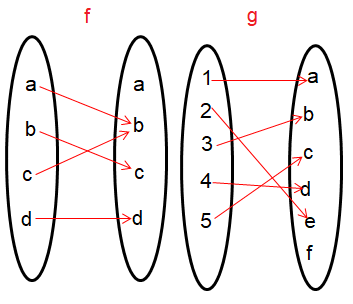
Find f∘f
i) f∘f :
Solution :
|
Input is a : f∘f (a) = f [f(a)] = f[b] = c So, (a, c) |
Input is b : f∘f (b) = f [f(b)] = f[c] = b So, (b, b) |
|
Input is c : f∘f (c) = f [f(c)] = f[b] = c So, (c, c) |
Input is d : f∘f (d) = f [f(d)] = f[d] = d So, (d, d) |
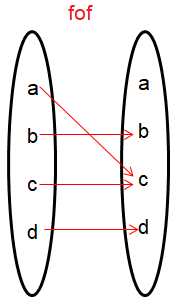
Problem 2 :
The arrow diagrams defines the functions
Find g∘g
i) g∘g :
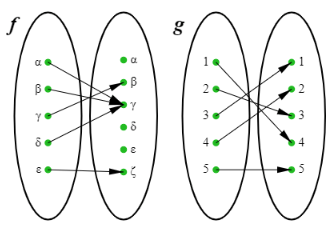
Solution :
|
Input is 1 : g∘g (1) = g [g(1)] = g[4] = 2 So, (1, 2) |
Input is 2 : g∘g (2) = g [g(2)] = g[3] = 1 So, (2, 1) |
|
Input is 3 : g∘g (3) = g [g(3)] = g[1] = 4 So, (3, 4) |
Input is 4 : g∘g (4) = g [g(4)] = g[2] = 3 So, (4, 3) |
Input is 5 :
g∘g (5) = g [g(5)]
= g[5]
= 5
So, (5, 5).
The required relation is
g∘g is { (1, 2) (2, 1) (3, 4) (4, 3) (5, 5) }
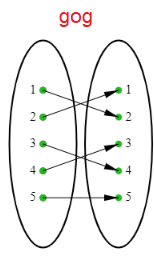
Problem 3 :
The arrow diagrams defines the functions
Find f∘g
i) f∘g :
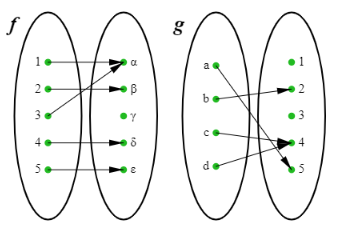
|
Input is a : f∘g (a) = f [g(a)] = f[5] = ε So, (a,ε) |
Input is b : f∘g (b) = f [g(b)] = f[2] = β So, (b, β) |
|
Input is c : f∘g (c) = f [g(c)] = f[4] = δ So, (c, δ) |
Input is d : f∘g (d) = f [g(d)] = f[4] = δ So, (d, δ) |
The required relation is,
{ (a,ε), (b, β), (c, δ), (d, δ) }
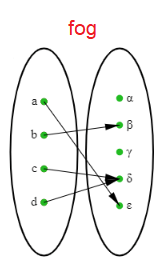
Problem 4 :
The arrow diagrams given define the functions
f : {a,b,c,d,e} → {a,b,c,d,e}
and
g : {a,b,c,d,e,f} → {a,b,c,d,e}.
Find the relation, f ∘ g
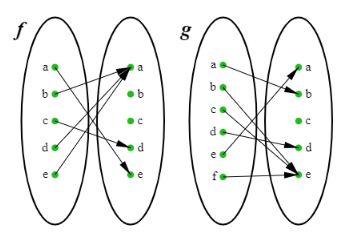
Solution :
|
Input is a : f∘g (a) = f [g(a)] = f[b] = a So, (a,a) |
Input is b : f∘g (b) = f [g(b)] = f[e] = a So, (b, a) |
|
Input is c : f∘g (c) = f [g(c)] = f[e] = a So, (c, a) |
Input is d : f∘g (d) = f [g(d)] = f[d] = a So, (d, a) |
|
Input is e : f∘g (e) = f [g(e)] = f[a] = e So, (e, e) |
Input is f : f∘g (f) = f [g(f)] = f[e] = a So, (f, a) |
So, the required relation is
{ (a,a) (b, a) (c, a) (b, a) (d, a) (e, e) (f, a) }
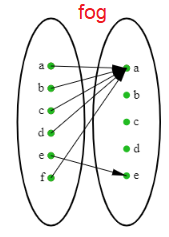
Problem 5 :
The arrow diagrams given define the functions
f : {1, 2, 3, 4} → {α, β, γ, δ, ε, ζ}
and
g : {1, 2, 3, 4, 5, 6} → {1, 2, 3, 4, 5, 6}.
Find the function for g ∘ g
Solution :
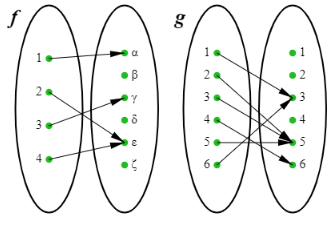
Solution :
|
Input is 1 : g∘g (1) = g [g(1)] = g[3] = 5 So, (1, 5) |
Input is 2 : g∘g (2) = g [g(2)] = g[5] = 5 So, (2, 5) |
|
Input is 3 : g∘g (3) = g [g(3)] = g[5] = 5 So, (3, 5) |
Input is 4 : g∘g (4) = g [g(4)] = g[6] = 3 So, (4, 3) |
|
Input is 5 : g∘g (5) = g [g(5)] = g[5] = 5 So, (5, 5) |
Input is 6 : g∘g (6) = g [g(6)] = g[3] = 5 So, (6, 5) |
So, the required relation is
{ (1, 5) (2, 5) (3, 5) (4, 3) (5, 5) (6, 5) }
Subscribe to our ▶️ YouTube channel 🔴 for the latest videos, updates, and tips.
Recent Articles
-
Finding Range of Values Inequality Problems
May 21, 24 08:51 PM
Finding Range of Values Inequality Problems -
Solving Two Step Inequality Word Problems
May 21, 24 08:51 AM
Solving Two Step Inequality Word Problems -
Exponential Function Context and Data Modeling
May 20, 24 10:45 PM
Exponential Function Context and Data Modeling